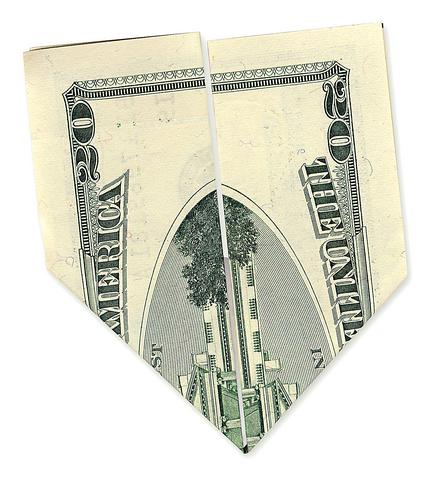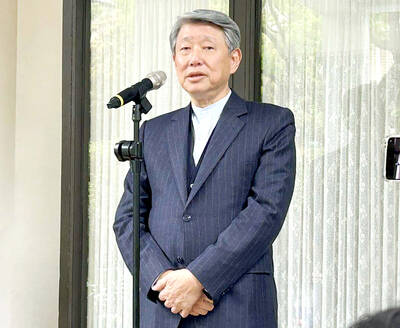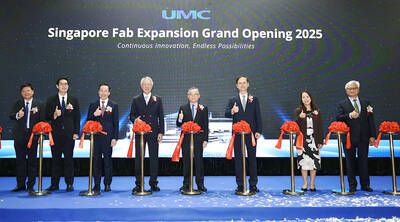Jeffrey Tobasky isn't into conspiracy theories. He doesn't care about the grassy knoll. Thinks people who claim they were abducted by UFOs are full of it and doesn't ever scan the horizon looking for the four horsemen of the Apocalypse.
But waiting in line at Dunkin' Donuts in Dorchester this week, he raised an eyebrow when handed a US$20 bill folded to show a bizarrely accurate image of the burning World Trade Center towers. Tobasky pursed his lips: "Damn, that's weird. I mean, that really is weird."

PHOTO: NY TIMES
The US$20 bill trick -- if that's the right word for it -- is also being done, to a lesser extent, with US$10 and US$50 bills, and has been spreading by word of mouth and over the Internet for at least a month. Whether coincidence or conspiracy, it's become something of a comment on the American psyche since the Sept. 11 attacks.
The trick goes back at least as far as a party in Melbourne, Florida, last month. Warren Dodd, who designs commercial Web sites, got together with about 20 friends on a Saturday to watch a NASCAR race on television. After a few laps, the race was rained out and Dodd walked out to the porch with a few friends. One of them pulled out a twenty, folded it lengthwise to hide the face of Andrew Jackson. Then, she folded the bill diagonally from the center point on the crease so it looked like an arrow -- or an airplane -- and there, clear as day, were the smoking Trade Center towers. Dodd turned the folded bill over and there was an image resembling the blown up Pentagon.
"I was really amazed," said Dodd, 47. "I mean, what are the odds?"
He showed a few friends and they were equally intrigued, so he decided to put it on a commercial Web site (www.allbrevard.net) to show friends out of state. After he posted it, he mentioned it on a computer user group. The next day, his site had 35,000 hits. The day after that it doubled to 70,000 and then doubled again and again, until it was getting about 250,000 hits a day. Since the posting about a month ago, the site has received more than 2 million hits, some from as far away as China and Israel. "It's gotten about the same exposure as a Super Bowl ad," Dodd said.
The responses on the site break down into three basic categories of roughly equal proportions: The people who, like Dodd and Tobasky, think the image is just a weird coincidence; those who think it's a sign that the government -- or God -- knew the attacks were coming; and those who think posting the image is sacreligious, wrong or at the very least, in bad taste. Tens of thousands also ask the question: "Who figured this out?" And thousands more have answered: "Someone with too much time on their hands."
Apocolypse now
Chip Berlet, a senior analyst at Political Research Associates in Somerville, Massachusetts and an expert on conspiracy theories, isn't at all surprised the image has spread so far so fast.
The roots of apocalyptic thinking in America, he said, go back to the 17th century. Whenever fear mixes with uncertainty, huge numbers of Americans fall back on simple stories of good versus evil. Unrelated objects and dates -- like Y2K or the fall of the Soviet Union -- are transposed into powerful end-of-the-world symbols.
The World Trade Center image is just the latest incarnation of this phenomena, Berlet says. Secret messages have been "discovered" in US currency for decades. When the Treasury Department redesigned paper money six years ago, "The 700 Club," a cable show led by televangelist Pat Robertson, reported that the government secretly implanted bills with the numbers 666, the so-called mark of the beast, Berlet said.
The US$20 can also be folded (like an accordion) to show the word "OSAMA" or (twice over Andrew Jackson's eyes) an erupting volcano. And the words "Novus Ordo Seclorum" under the pyramid on a US$1 bill are believed by some to translate into the words "New World Order."
Jim Hagdorn at the Bureau of Printing and Engraving has heard them all and fields questions with a voice hovering between fatigue and exasperation.
"People at the Bureau take great pride in their work and are very proud of the way the White House looks on the US$20 bill," Hagedorn said last week. "We feel really bad that this is being used to highlight the tragedy."
For Berlet its mostly amusing.
"Give me enough beer and I'll show you Donald Duck being sworn in as president on the dollar," he said.
"The point is you can do this all day and you can take any denomination and come up with pretty much whatever you want."
But for every self-styled realist who perceives the image as silly, there is someone else who isn't quite sure. Just ask Darrell Andersen, who bought lunch at D'Angelo's this week, about the same time Tobasky was patronizing the Dunkin Donuts next door.
"I think the government knew the attacks were coming, no doubt," Andersen said after he was shown the bill. "I think they know a lot things they don't tell us."

MULTIFACETED: A task force has analyzed possible scenarios and created responses to assist domestic industries in dealing with US tariffs, the economics minister said The Executive Yuan is tomorrow to announce countermeasures to US President Donald Trump’s planned reciprocal tariffs, although the details of the plan would not be made public until Monday next week, Minister of Economic Affairs J.W. Kuo (郭智輝) said yesterday. The Cabinet established an economic and trade task force in November last year to deal with US trade and tariff related issues, Kuo told reporters outside the legislature in Taipei. The task force has been analyzing and evaluating all kinds of scenarios to identify suitable responses and determine how best to assist domestic industries in managing the effects of Trump’s tariffs, he

TIGHT-LIPPED: UMC said it had no merger plans at the moment, after Nikkei Asia reported that the firm and GlobalFoundries were considering restarting merger talks United Microelectronics Corp (UMC, 聯電), the world’s No. 4 contract chipmaker, yesterday launched a new US$5 billion 12-inch chip factory in Singapore as part of its latest effort to diversify its manufacturing footprint amid growing geopolitical risks. The new factory, adjacent to UMC’s existing Singapore fab in the Pasir Res Wafer Fab Park, is scheduled to enter volume production next year, utilizing mature 22-nanometer and 28-nanometer process technologies, UMC said in a statement. The company plans to invest US$5 billion during the first phase of the new fab, which would have an installed capacity of 30,000 12-inch wafers per month, it said. The

Taiwan’s official purchasing managers’ index (PMI) last month rose 0.2 percentage points to 54.2, in a second consecutive month of expansion, thanks to front-loading demand intended to avoid potential US tariff hikes, the Chung-Hua Institution for Economic Research (CIER, 中華經濟研究院) said yesterday. While short-term demand appeared robust, uncertainties rose due to US President Donald Trump’s unpredictable trade policy, CIER president Lien Hsien-ming (連賢明) told a news conference in Taipei. Taiwan’s economy this year would be characterized by high-level fluctuations and the volatility would be wilder than most expect, Lien said Demand for electronics, particularly semiconductors, continues to benefit from US technology giants’ effort

‘SWASTICAR’: Tesla CEO Elon Musk’s close association with Donald Trump has prompted opponents to brand him a ‘Nazi’ and resulted in a dramatic drop in sales Demonstrators descended on Tesla Inc dealerships across the US, and in Europe and Canada on Saturday to protest company chief Elon Musk, who has amassed extraordinary power as a top adviser to US President Donald Trump. Waving signs with messages such as “Musk is stealing our money” and “Reclaim our country,” the protests largely took place peacefully following fiery episodes of vandalism on Tesla vehicles, dealerships and other facilities in recent weeks that US officials have denounced as terrorism. Hundreds rallied on Saturday outside the Tesla dealership in Manhattan. Some blasted Musk, the world’s richest man, while others demanded the shuttering of his